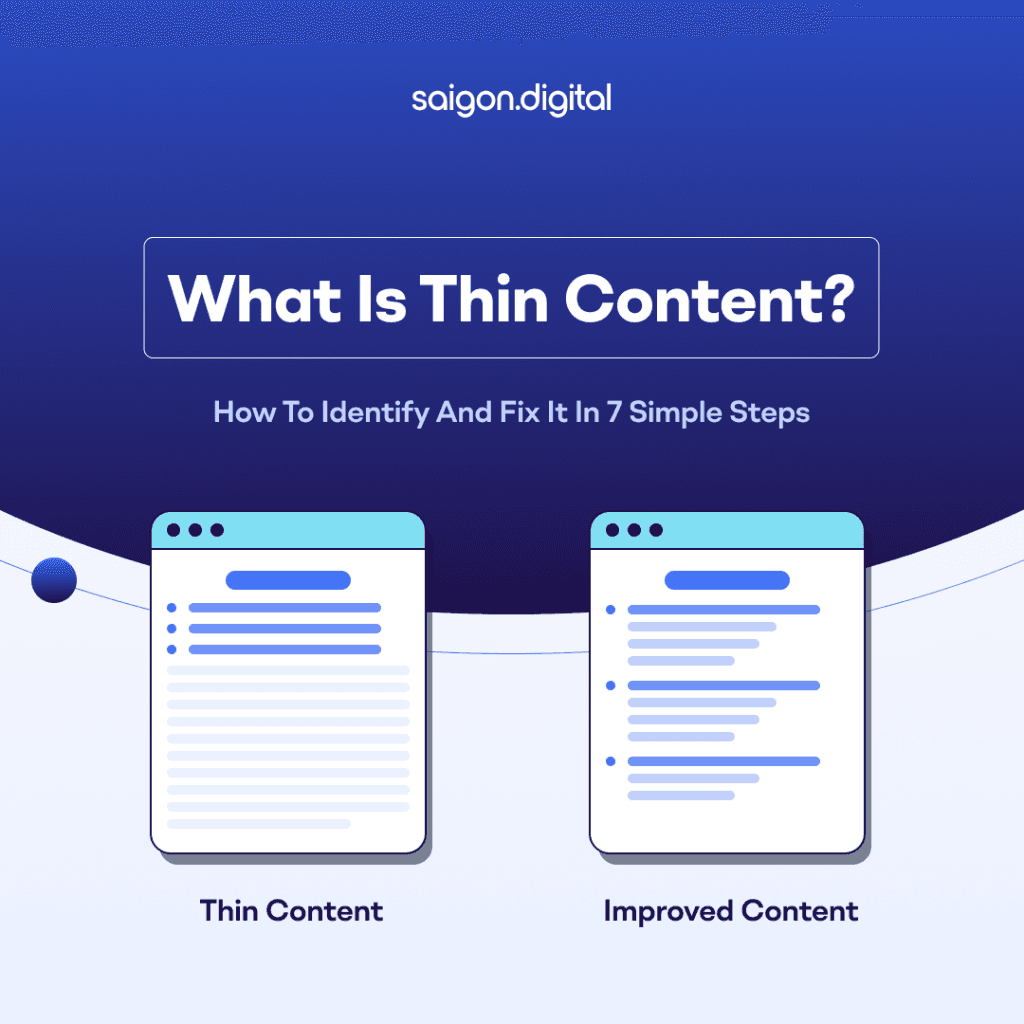
What Is Thin Content?
Thin content is website copy that offers little or no value to visitors and lacks depth, structure, or quality. In the rush to produce content, meet keyword targets, and stay ahead of competitors, it's easy to churn out superficial material. However, rather than boosting your search engine optimisation (SEO), thin content can actually harm it.
Google prioritises content that aligns with user search intent. When someone enters a search query, they expect to find a comprehensive answer. Short, unhelpful copy fails to fulfil this expectation. To convince Google that your website provides the information users seek, you need to deliver substantial, informative content.
What is Google's thin content penalty?
Google really doesn't like thin content. It's like they've got a big red cross over it. If you keep putting out rubbish, Google might even give you a time-out! That's called a penalty, and it's not good for your website's health.
Google started getting tough on thin content years ago with something called the Panda algorithm update. It was like a big clean-up of the internet, getting rid of all the rubbish content. And guess what? Google still cares about this stuff today.
Why Is Thin Content Bad For SEO?
Thin content is a real problem for your website's search engine optimisation (SEO). Here's why:- Poor user experience: If your content is thin, it's unlikely to offer much value to your visitors. This means they'll probably bounce off your site quickly, without exploring further. A high bounce rate is a red flag to search engines, suggesting your content isn't relevant or helpful.
- Keyword cannibalisation: Having multiple pages with thin content targeting the same keywords can confuse search engines about which page to rank. This can lead to your site appearing lower in search results for those keywords.
- Lack of credibility: Thin content can make your website seem less trustworthy. Google looks at things like experience, expertise, authority, and trust (E-E-A-T), and thin content doesn't score well in these areas.
- Google penalties: Creating thin content just to stuff it with keywords can violate Google's guidelines. This can result in penalties, which could seriously damage your website's search rankings.
Types of Thin Content
Thin content comes in many forms. Here are some common types to watch out for:- Low-quality content: This includes poorly written content with errors, content that's not helpful or informative, and content that simply doesn't deliver value to the reader.
- Duplicate content: This is when you have the same content appearing on multiple pages of your website or copied from other sites. It confuses search engines and offers no new information to visitors.
- Scraped content: This is content that's been copied from other websites without adding any original value. It's essentially stealing someone else's work.
- Affiliate content: While affiliate marketing can be legitimate, it's easy to create low-quality content focused solely on promoting products without providing any useful information.
- Ad-heavy content: Too many ads can distract visitors and make your content difficult to read. It can also harm your website's user experience.
- Doorway pages: These are pages created with the sole purpose of redirecting visitors to another page, often with little to no original content.
- Thin category, tag, and author pages: These pages should provide additional information about the content they relate to, but often they lack substance.
- Automatically generated content: Content created by computers often lacks quality, coherence, and relevance.
How To Identify Thin Content?
There are a few key ways to figure out if your website's content is a bit rubbish.
1. Check Your Google Search Console
Google Search Console is a brilliant tool for spotting thin content. It gives you a clear picture of how Google sees your site, which is exactly what you need.
One big clue is if your blog posts or landing pages aren't getting any search traffic, even though you've put in the effort to rank them. If you've spent time trying to boost a page's ranking and it's still nowhere to be seen, it might be a sign of thin content.
You should also check the "Manual Actions" tab to see if Google has flagged your site for any issues. Even though the name suggests manual penalties, many of these are actually caused by automated systems.
Finally, the "Coverage" tool is a goldmine for information about how Google sees your pages. Look at the "Excluded" section to see which pages Google has decided not to include in its search results. Pay close attention to these reasons:
- Crawled – currently not indexed
- Duplicate without user-selected canonical
- Duplicate, submitted URL not selected as canonical
- Duplicate, Google chose different canonical than user
2. Using Analytics
Once you've checked Google Search Console for potential issues, it's time to dive into Google Analytics. Here, you're looking for any sudden drops in organic traffic. These dips could be caused by a few things:- A Google penalty: If you've been naughty and created some rubbish content, Google might punish you.
- Algorithm updates: Google's always changing its mind, and sometimes these changes can affect your traffic.
- Seasonal changes: Some businesses experience natural ups and downs in traffic throughout the year.
- Data glitches: Sometimes, there can be errors in the data you're seeing.
Look carefully at any pages that have experienced a significant drop in visitors. These pages are likely candidates for thin content. If traffic has consistently been low for these pages, it's even more likely they're not cutting the mustard.
Make a note of these pages and add them to your list for a closer look.
3. Check Your URLs
Duplicate content is a big problem when it comes to thin content, so it's important to find and fix it. One way to do this is by taking a good look at your website's URLs. If you spot pages with similar addresses, there's a good chance they might be too similar.
Once you've got a list of similar URLs, check the keywords and titles. If they're pretty much the same, it's likely that the content is also similar.
4. Keep an Eye on Rankings
Using a rank tracker is a great way to stay on top of your website's performance. This tool can help you spot problems with thin content and keyword cannibalisation. By tracking your keyword rankings, you can quickly see if a page is dropping in the search results or disappearing altogether.
I once had a nightmare where Google decided to rank a French version of one of our articles for English keywords. Our original English article plummeted from the top three search results to the very last page! This shows how important it is to keep a close eye on your rankings.
A good rank tracker can help you catch these issues early and fix them before they do too much damage.
5. Crawl Your Website
The next crucial step in finding thin content is to actually crawl your website. This means using a tool to scan every page and look for problems. Powerful tools like Screaming Frog are great for this, but they can be a bit complicated.
If you suspect you have a few pages with thin content, there are simpler options. Plagiarism checkers can help you spot similar content across your website. Free tools like DupliChecker and Siteliner are easy to use and can give you a quick overview.
6. Check Titles and Meta Descriptions
Another way to find potential thin content is by checking your page titles and meta descriptions. These are the short snippets that appear in search results. If you have multiple pages with the same or very similar titles and descriptions, it could be a sign of thin content.
Tools like Screaming Frog can help you find these duplicates. Even the free version can scan up to 500 pages. Just enter your website address and wait for the scan to finish. Then, look at the following sections:
- Title 1
- Title 1 Length
- Meta Description 1
- Meta Description 1 Length
If you see a lot of repeated information here, it's time to dig deeper into those pages.
7. Read Through Your Webpages
Sometimes, the best way to find thin content is simply by reading through your website with fresh eyes. Good content should teach readers something new. It should answer the questions:
- What are you talking about?
- Why does it matter?
- How can people use this information?
If your page doesn't do these things, or if it feels like you've seen similar content elsewhere, it's probably thin content.
While this method is time-consuming, it's essential for identifying content quality issues that automated tools might miss.
How To Fix Thin Content?
To fix thin content on your website, consider the following steps:- Expand and Enrich Existing Content: Identify pages that lack depth or detail. Add more comprehensive information, such as detailed explanations, examples, and subtopics. Incorporating multimedia elements like videos, images, and infographics can further enhance the content’s richness.
- Consolidate Similar Content: If you have multiple pages with overlapping information, consider merging them into a single, robust resource. This reduces redundancy and strengthens the content's overall quality.
- Improve User Engagement: Engage your audience by making your content more interactive. Include quizzes, surveys, or comment sections to encourage visitors to spend more time on your site. Multimedia elements also make content more engaging.
- Regularly Update Content: Outdated information can diminish content value. Regularly review and refresh your content to ensure it remains relevant and useful to your audience. This not only helps in keeping your content current but also improves its performance in search engines.
- Add Credible References and Expert Insights: Enhance the authority of your content by including expert opinions, case studies, and references to reputable sources. This adds credibility and makes your content more valuable to readers.
- Align Content with User Intent: Ensure your content meets the specific needs and queries of your audience. Focusing on user intent makes your content more meaningful and effective.
- Prioritise Quality Over Quantity: Rather than producing numerous pages with minimal content, concentrate on creating fewer, high-quality pages. Comprehensive, well-researched content is more likely to satisfy users and rank better in search engines.





